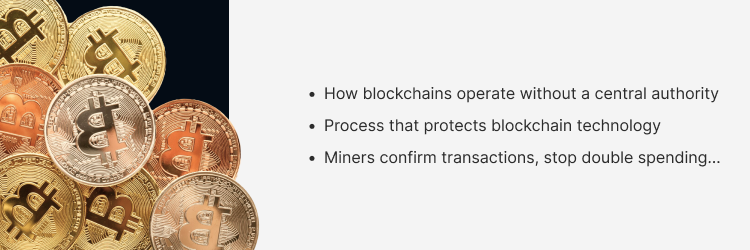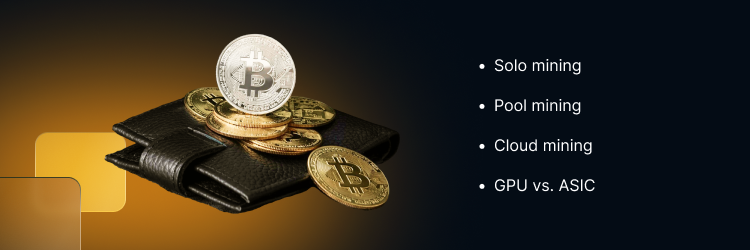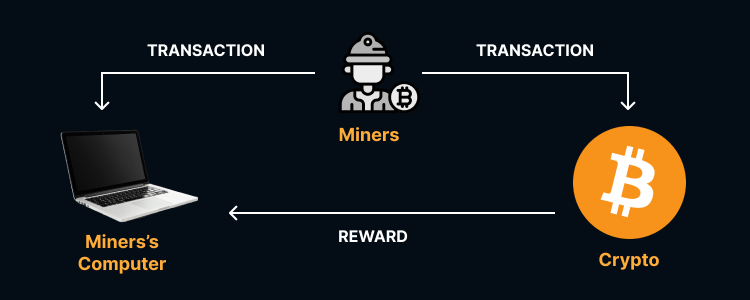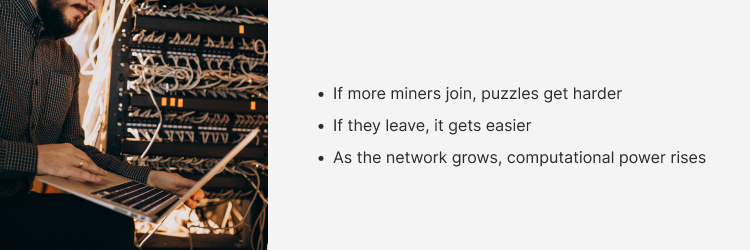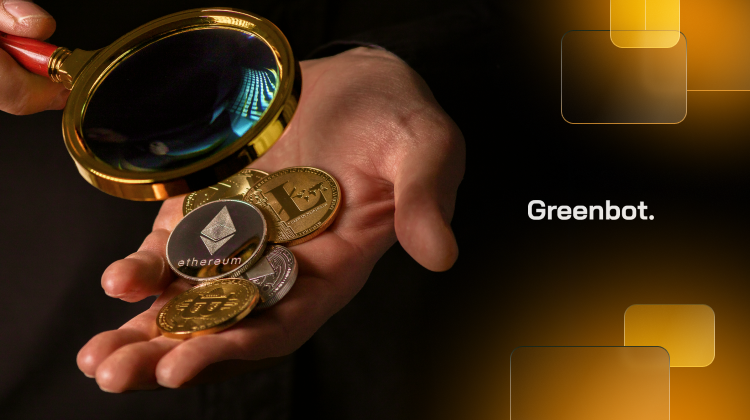
How does crypto mining work? It’s not digging in the dirt — it’s using computers to solve math puzzles and earn digital coins. Like mining gold, it takes effort and gear. The mining process powers coins like Bitcoin.
Crypto mining supports digital currencies by verifying transactions, securing the network, and creating new coins. Cryptocurrency mining keeps blockchains running smoothly, eliminating the need for banks or intermediaries. It’s how coins stay trustworthy.
Miners use machines to solve puzzles. The first to crack one gets rewarded. This guide walks you through the process of crypto mining, the hardware required, and what it takes to be profitable today.
What Is Cryptocurrency Mining?
Cryptocurrency mining is how blockchains, such as Bitcoin, operate without a central authority. Miners contribute by validating transactions and ensuring the accuracy and security of the system.
Mining is the process that protects blockchain technology. Miners confirm transactions, stop double spending, and add new data to the chain. That’s what keeps crypto mining work decentralized and trusted.
How Does Bitcoin Mining Work?
Bitcoin mining work runs on a system called proof of work. This means miners race to solve a puzzle using computing power. The fastest one validates the transactions and wins a reward.
Here’s how bitcoin mining works:
- New transactions are grouped into a block;
- Miners link it to the last Bitcoin blockchain block;
- They solve a complex puzzle using a nonce and hashing;
- First one to solve it broadcasts the result;
- Others verify, and the block gets added;
- The winner receives new coins and fees.
This protects the network and makes cheating too expensive.
Different Methods of Mining Cryptocurrencies
There’s more than one way to start mining cryptocurrency. Each method has its pros, risks, and hardware needs. Here’s how crypto mining varies:
- Solo mining: You mine alone using your own gear. It’s rare to hit a block solo unless you’ve got massive power.
- Pool mining: You join others in mining pools, combining computing power. Rewards are smaller but steady, based on your share of the crypto mining work.
- Cloud mining: You rent mining power from a third party. You skip the gear, but risks are high, and scams are common.
- GPU vs. ASIC: Bitcoin mining needs ASICs—custom machines built for speed. Some altcoins still work with GPU rigs, but Bitcoin does not.
How to Start Bitcoin Mining
Want to be a bitcoin miner? It’s not a quick win—it takes gear, time, and money. Here’s how to start Bitcoin mining, step by step:
1. Choose a Coin
Choose your target: Bitcoin mining or another cryptocurrency. Bitcoin pays better, but it requires more expensive hardware. Altcoins may be easier to mine, but less profitable.
2. Select Mining Hardware
To mine Bitcoin, get an ASIC miner. Bitcoin miners need high hash rates and efficiency. GPUs won’t cut it anymore. ASICs are expensive and require a lot of cooling.
3. Pick a Pool
Solo mining is dead. Join a reliable pool to share power and split rewards. Compare fees, payout methods, and uptime before making a commitment.
4. Install Mining Software
Download and install software made for your ASIC and pool. It may require some setup, either through the command line or a control panel.
5. Set Up a Crypto Wallet
Create a wallet to receive your earnings. Choose one that is secure and supports the cryptocurrency you mine. This is where your pool sends your cut.
6. Start Mining
Connect your hardware, launch your software, and begin. Monitor your stats, energy costs, and hash rate regularly. That’s how every crypto miner starts.
Curious about global crypto expansion? Read how Russia plans to turn surplus power into a Bitcoin mining hub in the Far East.
What Do Crypto Miners Do?
Crypto miners are crucial to Proof-of-Work networks, such as Bitcoin. They keep the system running without central control. Every crypto miner helps confirm transactions and protect the blockchain.
Miners validate blocks by solving puzzles. Their mining work builds trust and ensures all history is legit. Crypto miners compete for rewards by solving blocks before anyone else.
What Is the Mining Process?
The mining process is a nonstop cycle that powers the blockchain. It starts by grabbing transactions, bundling them into a block, and solving a mathematical puzzle using brute force.
Miners validate transactions, race to find the correct hash, and share the block once it is solved. If verified, the new block is added to the chain. Winners earn rewards and fees. Bitcoin’s average block time is about 10 minutes.
What Are Mining Pools?
Mining pools enable individual miners to team up and increase their chances of earning rewards. It’s nearly impossible to mine solo today—other miners in a pool help carry the load.
Everyone contributes processing power. When one miner solves the puzzle, the mining pool splits the reward based on each person’s share of work.
Mining Hardware: What Do You Need?
You can’t mine crypto without solid mining hardware. Forget your laptop—this game needs serious gear.
- ASIC miners: These application specific integrated circuits are custom-built machines. Perfect for Bitcoin, but expensive and noisy.
- Graphics processing units (GPUs): Used for altcoins. Less efficient, but more flexible.
- Strong cooling systems, reliable internet, and solid computing power are non-negotiable.
- Specialized computers are a huge upfront cost, but vital for staying competitive.
Mining Difficulty and Network Competition
Mining difficulty changes every two weeks. If more miners join, puzzles get harder. If they leave, it gets easier.
As the network grows, computational power rises. That means computing power required per miner also rises. You need more energy, speed, and money to continue earning.
How Are Crypto Miners Rewarded?
Miners earn two main mining rewards: block rewards and transaction fees.
- Block rewards are fixed payouts in new coins. A block reward started at 50 BTC, but halves every four years. In 2025, there will be 3.125 new bitcoins.
- Miners also keep any transaction fees from the block they solve.
Environmental Impact of Crypto Mining
The environmental impact of crypto mining is serious. Electricity costs are massive because millions of rigs run 24/7. That’s a huge total energy consumption—Bitcoin uses more power than most countries.
Unlike the extraction of gold, mining Bitcoin primarily uses fossil fuels. That contributes to the carbon footprint generated by every coin mined.
Proof of Work vs Proof of Stake
Proof of work makes miners compete by doing mining work to solve a puzzle and validate transactions. It’s secure but energy-heavy.
Proof of stake allows users to lock coins to validate transactions, rather than wasting power. It’s faster, cheaper, and greener—two very different systems to run the mining process.
| Feature | Proof-of-Work | Proof-of-Stake |
| Mechanism | Computational Puzzle | Economic Stake |
| Energy Use | Very High | Very Low |
| Hardware | ASICs/GPUs | Less Specialized |
| Who Validates | Puzzle Winner | Based on Stake |
| Main Drawback | Energy & Hardware Race | Wealth Concentration |
How Long Does It Take to Mine 1 Bitcoin?
How long will it take to mine 1 bitcoin? On your own? Ages. Even a decade. It’s not realistic.
In pools, you earn fractions of one bitcoin steadily. Speed depends on hardware, bitcoin mining difficulty, your hash rate, and luck. ASICs help. So does low power cost. But it’s still slow.
FAQs About Crypto Mining
What is crypto mining in simple words?
Crypto mining refers to the process of using computers to verify transactions on a blockchain. You help keep the system secure and get paid in coins. It’s how new coins are created and how the network stays safe without banks.
Can you mine crypto on your phone?
Not really. Phones can’t handle the demands of mining cryptocurrency. They’re too weak, too slow, and not built for it. Apps that claim to do it often mislead or focus on worthless tokens.
Is mining still profitable in 2025?
Barely. Unless you’ve got cheap power and top gear, profits are slim. Crypto miners now compete with giant farms. If your electricity is expensive, you’ll likely lose money instead of making it.
What coins are easiest to mine today?
The “easiest” coins usually have low competition, but also low value. They may work with GPUs, but profits vary a lot. Even if mining’s easy, it doesn’t mean it’s worth it.
Why is mining important for crypto?
Mining keeps crypto honest. It secures networks like Bitcoin, validates transactions, and stops double spending. Without mining rewards, blockchains would fall apart. It’s the backbone of decentralized systems.
Final Thoughts on How Crypto Mining Works
So, how does crypto mining work? It powers coins like Bitcoin by solving puzzles, confirming data, and earning rewards. However, its demanding work—cryptocurrency mining requires specialized equipment, continuous energy, and substantial investment.
If you’re considering it, weigh your setup. You’ll need the right mining hardware, cheap electricity, and time. Most solo miners join mining pools to improve their odds. Before jumping in, ask yourself if you can afford the risk and still come out ahead. Mining isn’t just tech—it’s business.


